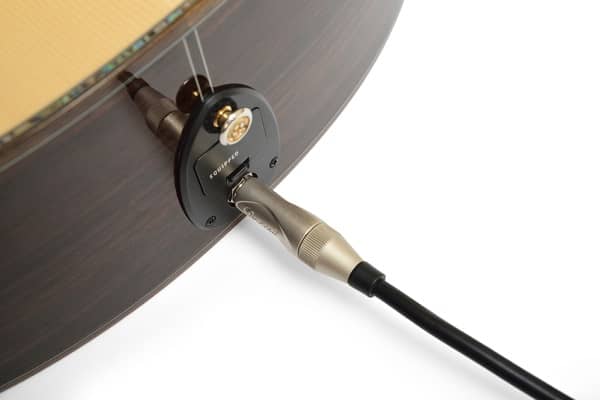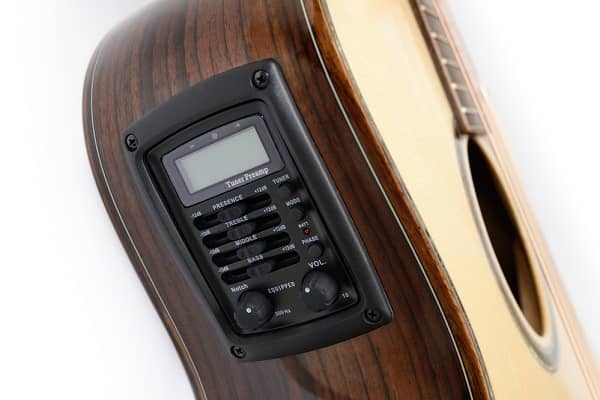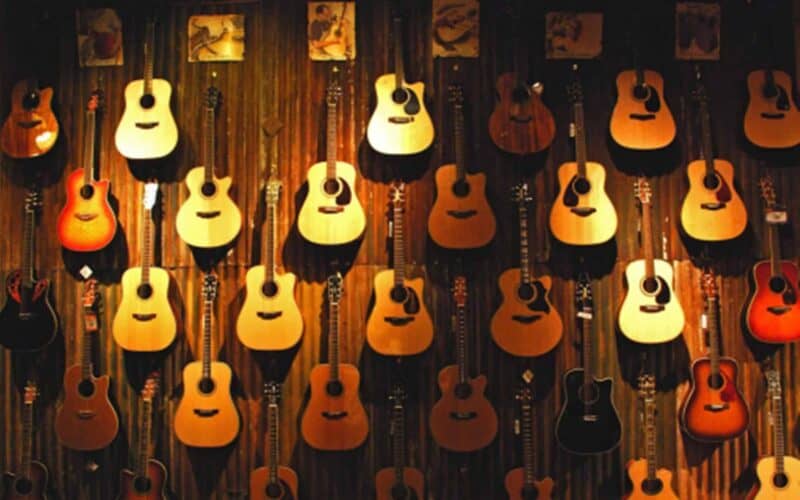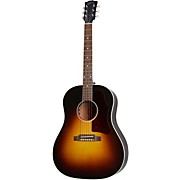As a guitarist, I know the struggle of finding a quality acoustic-electric guitar that truly captures the rich acoustic tone while also amplifying well. Acoustic-electric guitars have surged in popularity for their versatility to switch between unplugged and amplified sounds.
In this article, I’ll cut through the dizzying options by recommending the top 7 acoustic electrics across all price ranges based on extensive hands-on testing. I evaluated construction, electronics, playability, and that ideal blend of natural acoustic sound and amplified performance.
Whether you’re a beginner seeking your first plugged-in acoustic or a pro finding your next go-to gigging guitar, you’ll discover reliable picks tailored to your needs and budget here.
Read on because you’ll gain indispensable knowledge to invest in your ideal acoustic-electric guitar confidently.
List of Top Acoustic Electric Guitars
- Martin 000-28E Modern Deluxe – Best High-End Choice
- Gibson 50s J-45 Original – Best Professional Acoustic-Electric Guitar
- Martin DJR-10E StreetMaster – Best for Travel and Portability
- Gretsch G9520E Gin Rickey – Best for Beginners
- Yamaha A5R ARE Dreadnought – Best for Giging and Stage Performance
- Taylor 214CE Deluxe – Best for Recording
- Fender American Acoustasonic Telecaster – Best Hybrid Model
Quick Recommendations Of Electro Acoustic Models
If I had to narrow it down to just three stellar acoustic-electrics that would cover most players’ needs, I would choose the Gretsch G9520E for its unbelievable quality and features at under $300 – fantastic for beginners and intermediates on a budget.
The Martin DJr-10E is so lightweight and comfortable to play perfect for travel, while sounding fantastic plugged in. The Fender Acoustasonic Telecaster is incredibly versatile, letting guitarists easily switch between acoustic and electric tones making it ideal for diverse playing styles.
With top-notch construction and electronics, these models offer superb amplified sound and playability to match musicians’ needs from traveling troubadours to working guitarists gigging every weekend. For most players, you can’t go wrong with these three.
Review of Best Electric-Acoustic Guitar
1. Martin 000-28E Modern Deluxe Acoustic Electric Guitar
- Delivers a rich, aged sound with powerful tones
- The guitar look is as captivating as it sounds
- Handmade from the highest-quality wood
- Fishman Aura VT Blend electronics allows more control
Key Specifications:
- Body Shape: 000
- Top Wood: Solid Sitka spruce
- Back & Sides: Solid East Indian rosewood
- Neck Wood: Select hardwood
- Scale Length: 24.9 inches
- Electronics: Fishman Aura VT Blend
- Standout Feature: Torrefied top for vintage tone
The Martin 000-28E Modern Deluxe puts a contemporary spin on a classic orchestra model acoustic. Built with premium solid woods like Sitka spruce and Indian rosewood, it achieves the balanced and intimate 000 tone.
But modern appointments like the torrefied top, Liquidmetal bridge pins, and carbon fiber bridge plates give this guitar a loud and vibrant voice. The Fishman Aura electronics blend the crisp piezo pickup sound with custom mic’d images for rich, detailed amplified tone.
From fingerstyle playing to rhythm strumming, the 000-28E provides exceptional touch sensitivity and dynamic range. With its smaller body and slim neck, it offers comfortable playability too.
If you seek a modern high-end acoustic with iconic Martin design and upgraded contemporary personalities for discerning players, the 000-28E is a standout choice worth the splurge.
Pros:
- Loud and vibrant acoustic voice
- Premium woods and modern updates
- Versatile Fishman electronics
Cons:
- Too much expensive
2. Gibson 50s J-45 Original Acoustic Electric Guitar
Key Specifications:
- Body Style: Round shoulder dreadnought
- Top Wood: Solid Sitka Spruce
- Back & Sides: Mahogany
- Neck Wood: Mahogany
- Scale Length: 24.75 inches
- Electronics: LR Baggs VTC pickup w/ tone & volume controls
- Standout Feature: Iconic workhorse acoustic tone
The Gibson J-45 Original is a top choice for pros seeking the classic workhorse acoustic electric known for its balanced warm tone.
Built with all solid tonewoods like sitka spruce and mahogany, it achieves a rich and dynamic voice, while the slim neck offers easy playability. The LR Baggs pickup faithfully amplifies the J-45’s coveted acoustic sound.
This guitar delivers on all fronts, from its resonant construction to versatile electronics to smooth playability. For a high-end acoustic-electric with a timeless design that expertly blends vintage style and modern reliability, the J-45 Original stands out as a trusty companion on stage and in studio.
Pros:
- Balanced and warm acoustic tone
- Quality handmade construction
- Slim neck for comfort
Cons:
- High price tag
3. Martin Junior Series DJR-10E StreetMaster
- Delivers the booming, full sound of a dreadnought
- Featuring a distinctive, distressed finish
- Comfortable and playable with a thin body
- StreetMaster provides reliable, clean acoustic tone
Key Specifications:
- Body Shape: D Junior-14 Fret with slimmer 000 depth
- Top Wood: Solid Sapele
- Back & Sides: Sapele
- Neck Wood: Select Hardwood
- Scale Length: 24 inches
- Electronics: Fishman Presys VT
- Standout Feature: Portable short-scale design
The Martin D Jr-10E StreetMaster rethinks the classic dreadnought shape into an impressively compact travel-ready acoustic electric. Its smaller 000 body depth and shorter 24-inch scale length enhance playability and portability.
Yet constructed with all solid tonewoods like sapele, it still achieves trademark Martin warmth and richness, suited for strummers and fingerpickers alike. The discreet Fishman Sonitone system faithfully amplifies this voice while an onboard tuner provides convenient tuning on the go.
For an exceptional value in a uniquely road-worthy acoustic-electric, the Martin Jr-10E StreetMaster should be on your radar.
Pros:
- Quality all-solid wood body
- Rich and resonant acoustic tone
- Shorter scale and slim body for a travel-friendly design
Cons:
- Mid-range amplified tone
4. Gretsch G9520E Gin Rickey
- Basswood body with X-bracing
- 12th fret, 24”-scale nato set neck with 12” radius walnut fingerboard
- Gretsch Deltoluxe soundhole pickup with gold/white rosette rings
- 1950s-style vintage open-gear die-cast tuning machines and vintage end-pin strap buttons
Key Specifications:
- Body Style: Parlor
- Top Wood: Basswood
- Back & Sides: Basswood
- Neck Wood: Nato
- Scale Length: 24 inches
- Electronics: Gretsch Deltoluxe Soundhole Pickup
- Standout Feature: Throaty amplified blues tone
The Gretsch Gin Rickey parlor acoustic-electric guitar punches above its weight with a uniquely gritty amplified tone well-suited for blues and folk playing. Its compact, vintage-inspired body offers comfortable playability that beginners will appreciate.
Though made of budget basswood, the smaller shape provides focused mid-heavy warmth. The custom Gretsch Deltoluxe magnetic pickup then takes that acoustic character into fat overdriven territory, cutting through a mix with its signature bluesy snarl.
The Gretsch Gin Rickey is perfect for plugging into an amp and is wallet-friendly, making it an ideal choice for dipping your toes into amplified acoustic tones on a starter player budget.
Pros:
- Easy short-scale playability
- Warm blues acoustic tone
- Custom overdriven pickup sound
Cons:
- Lacks acoustic volume and treble clarity
- Love-it or leave-it looks
5. Yamaha A5R ARE Dreadnought
- 6-string Acoustic-electric Guitar with Solid Sitka Spruce Top
- Ebony Fingerboard - Vintage Natural
- Solid Rosewood Back Sides
- Mahogany Neck
Key Specifications:
- Body Shape: Cutaway Dreadnought
- Top Wood: Solid Sitka Spruce
- Back & Sides: Solid Rosewood
- Neck Wood: African Mahogany
- Scale Length: 25.6 inches
- Electronics: SRT2 Preamp with Blendable Piezo & Mic Modeling
- Standout Feature: Stage-ready Amplified Versatility
The Yamaha A5R ARE stands out in the world of acoustic-electric guitars, earning its spot as the top choice for gigging and stage performances. Crafted with precision, the torrefied Spruce top and solid Rosewood sides produce a warm, vintage voice that resonates beautifully, making it suitable for various playing styles.
The real magic lies in the SRT2 electronics. The unique mic blend system combines a piezo pickup with a digitally recreated mic sim, offering the flexibility to mimic a Neumann or a Royer Ribbon.
This innovation ensures that whether you’re strumming with a pick or fingerpicking, your sound cuts through without losing the organic acoustic character.
If you need a workhorse acoustic electric to rely on across any gig or session without compromise, the Yamaha A5R is ready to impress on all sonic fronts.
Pros:
- Quality torrefied solid wood dreadnought tone
- Onboard preamp offers versatility and exceptional mic simulation
- Reliable build and hardware
Cons:
- Limited aesthetic options with no non-cutaway version
- Aesthetically, it might be considered a bit plain
6. Taylor 214CE Deluxe Grand Auditorium
- Delivers peak playability, a full and articulate voice
- Ensures solid volume even in response to light fingerpicking
- Taylor ES2 electronics includes behind-the-saddle pickup
- ES2 faithfully conveys the voice of your Taylor guitar
Key Specifications:
- Body Shape: Grand Auditorium
- Top Wood: Solid Sitka Spruce
- Back and Sides: Layered Rosewood
- Neck Wood: Sapele
- Scale Length: 25.5 inches
- Electronics: Expression System 2
- Standout Feature: Behind-the-saddle pickup with three uniquely positioned sensors for capturing dynamic range
Priced in the four digits, the Taylor 214CE Deluxe is an elite acoustic-electric guitar catering to recording enthusiasts. Its solid Sitka Spruce top and layered rosewood back and sides produce a potent, clear tone that improves with play.
The Grand Auditorium’s body shape ensures comfort without sacrificing sound richness. Despite the Sapele neck not matching some high-end counterparts, its slim design guarantees a comfortable grip, aided by a convenient cutout for seated play.
Noteworthy for tonal clarity, the guitar features Taylor Standard II Bracing for enhanced projection and balance. The Expression System 2, offering “professional audio”-grade electronics with a behind-the-saddle pickup, captures dynamic range adeptly.
Priced above $1000, the 214CE Deluxe justifies its cost with quality construction, innovative electronics, and exceptional sound reproduction – making it ideal for intermediate and professional musicians seeking stage-worthy playability and recording capabilities.
Pros:
- Solid wood construction for enhanced sound quality
- Clear and powerful tones from the Sitka Spruce top
- Comfortable playability with the Grand Auditorium body and slim neck
- Taylor Expression System 2 delivers authentic sound on stage
Cons:
- Relatively expensive
- Sapele neck may not match the premium feel expected in this price range
- Lack of a built-in tuner might be inconvenient for some players
7. Fender American Acoustasonic Telecaster
- Cutting-edge acoustic-electric guitar
- Revolutionary acoustic shape-shifting and electric tones
- Offers 5 distinct voice pairs – a curated collection of acoustic and electric voices
- Integrated forearm and back contour, and mahogany Modern "Deep C" neck
Key Specifications:
- Body Shape: Modified Telecaster
- Top Wood: Solid Sitka Spruce
- Back and Sides: Mahogany
- Neck Wood: Mahogany
- Scale Length: 25.5 inches
- Electronics: Fishman Under-saddle Transducer, Fishman Acoustasonic Enhancer, and Fender Noiseless Magnetic Pickup
- Standout Feature: 10 different acoustic and electric voices that can be blended with a Mod knob
The Fender American Acoustasonic Telecaster, a groundbreaking hybrid guitar, seamlessly blends acoustic and electric elements for versatile musical expression.
Boasting a unique hollow body with a solid spruce top and mahogany back and sides, this lightweight and comfortable instrument produces a rich acoustic sound, further enhanced by the String Instrument Resonant System (SIRS).
The mahogany neck, with a contoured heel and ebony fingerboard, ensures a smooth and fast playing experience. At the heart of its innovation is the Acoustic Engine, a collaboration between Fender and Fishman.
This engine, comprising three pickups, enables 10 voices mimicking various body styles and tone woods. The guitar excels both acoustically and electrically, featuring a noiseless N4 magnetic pickup for classic Telecaster tones.
The Acoustasonic Telecaster, albeit carrying a premium price, delivers exceptional value, catering to players of all levels and musical styles. It serves as a source of inspiration for exploration and creativity, making it a worthy investment for any guitarist.
Pros:
- Smart design, build and execution
- Very credible plugged-in acoustic voices
- An inspired clean-to-crunch magnetic voice
- Lightweight and comfortable Tele platform
Cons:
- No left-handed option
- Some minor issues with the acoustic voice balance
- Expensive
Acoustic Electric Guitar Reviews: Buyer’s Guides
When you are willing to purchase an instrument of any kind, it’s natural you would want to know every detail about it, including why it is also the right choice for you and such.
Depending on your budget and the kind of music you want to play, shopping for the perfect instrument can be bothersome and somewhat confusing unless you have prior experience regarding it.
In any case, since this article revolves around acoustic-electric guitars, there are some important notes you should take down while buying one.
What is an Acoustic-Electric Guitar?
First, let us get to know what an acoustic-electric guitar really is. Unlike your usual acoustic guitars, acoustic-electric guitars have an inbuilt pre-amplifier, which you can easily plug into an amplifier or into a sound system.

The great thing about an acoustic-electric guitar is that it still manages to produce the sounds you would expect from a traditional acoustic guitar. The greater side to it is that the same rich acoustic sounds will be amplified naturally, allowing you to comfortably play in public areas as well if you will.
Note that when you do not have your acoustic-electric guitar plugged into an amplifier or into a sound system, you can still play it just as you would play a traditional acoustic guitar.
Also Read: Differences between Acoustic And Acoustic-Electric Guitar
The Design And Structure Of Electro Acoustic Guitar
When choosing the right acoustic-electric guitar you should learn how one is built beforehand. This will help you a lot in the future when you have to figure out exactly what sort of sound can be created with the help of your guitar.
Neck
Starting with the most basic part of a guitar, the neck is usually attached to the body of the guitar. This type of neck is one that we term as ‘set neck’, as in it is glued to the body. However, some guitars have an alternative to the neck type, introducing a ‘bolt-on neck’ system.
On the neck, there is a metal truss rod, which helps to prevent the neck from wilting or twisting due to the tension from the strings. You can easily adjust the truss rod of the guitar, which will also allow you to correct intonation errors.
Fretboard
Also known as the fingerboard, this is usually a piece of sturdy wood set into the guitar neck, at half-step increments over the course of the 12-tone scale. The fretboard is where you can find different notes.
Some models of guitars have dots on the fretboard while others may have odd-numbered frets or symbols. The fretboard is most commonly made up of ebony or rosewood.
Headstock
This is located at the very end of the neck of the guitar, hence called the headstock as this is where the soundboard of the guitar starts from. The headstock consists of tuners and machine heads which help to adjust the tension and pressure on each string, allowing you to alter their pitches accordingly.
On the very top of the soundboard, where the headstock meets the neck, you will find a nut. The nut is commonly constructed of graphite, bone, or sometimes also plastic.
Body of Electro-Acoustic Guitar
Soundboard
As I previously mentioned, the body is where the soundboard is located. The soundboard is also supported by some internal bracing. These are the sides of the soundboard, there is the back of the board comes together to form a hollow chamber in the middle.
Know that the middle of a guitar is known as the waist while the upper and lower body curves are known as the upper and lower bouts respectively.
Know that the larger a soundboard, the deeper and louder the sound will be produced.
Soundhole
The sound hole is associated with the waist of the guitar, right at the very base of the fretboard.
The sound hole is through which the sounds produced by the user and the strings are resonated. Often times you will find a plastic pickguard at the base of the fretboard.
Size and Shape
These two factors influence how useful the guitar can really be. They play an important part in the sound and in the playability of the instrument as a whole.
Finding a guitar with the right shape and size is a completely personal decision because you will be the one playing it after all. Hence, the user needs to make sure if the shape and the size of the guitar are comfortable or not.
Strings
Strings are probably the most necessary part of a guitar. Properly attached and well-tuned strings play a big role when creating music. The strings are set at the body of the guitar, connected to the bridge.
There are bridge pins that hold onto each string. There is a part called the saddle that has thin strips of materials such as plastic or bone that separate each string from one another.
For beginners, go for guitars with nylon strings as they are much softer on the tips of your fingers. Nylon strings also project more mellow and softer tones as well. However, steel strings are more commonly used by guitarists who prefer playing music a bit more loudly.
Top
The top of a guitar is what affects the tone and quality of the music produced the most. The top of an acoustic-electric guitar is most commonly made of laminate or solid wood.
Solid wood is a better choice for guitar manufacturing as the quality of the tone resonated is more rich and vibrant, while the tone resonated through a laminate top is not as rich.
However, laminate is much cheaper than guitars with a solid wood top, hence being a good choice for beginners or for those who are tight on their budget.
Type of Wood Used in Acoustic-Electric Guitar
There are a lot of wood qualities that influence the tone of the music, but it can be quite confusing to choose just one. Some of the wood we have here are the most common ones used in acoustic-electric guitars.
Cedar- Guitars made of cedar wood produce bright tones.
Ebony– Ebony is usually used for the fretboard of a guitar, as it is very sturdy but also has a sleek texture to it.
Cocobolo- This Mexican wood is very strong and hence mostly used for the sides and backs of a guitar. The tone projected is very bright with this wood.
Mahogany- Guitars made of Mahogany produce strong tones as it is a very opaque wood. Guitars of mahogany are usually used to play high-end tones such as blues or country music.
Spruce- A standard for acoustic-electric guitars, spruce is strong while being lightweight at the same time. There are also variations of the type of spruce used, ranging from Sitka, European Spruce, etc, each with its own distinct quality and colors.
Maple- Guitars with sides and backs made of maple are great for a live event as the sound produced is somewhat ‘dry’. If you know you will be playing in a group or as a band, going for a guitar of maple wood is smart as the sound from the guitar can still be heard even under a mix of other various instruments.
Sapele- Sapele is an African wood that is mostly used for the back and sides of guitars. The tonal quality is similar to that of mahogany however it adds a little more treble to it.
Benefits of an Acoustic Electric Guitar

An Acoustic-Electric Guitar is one such type of guitar that gives you the best of both worlds at the same time. With an Acoustic-Electric Guitar, you can enjoy the classical tone of a traditional acoustic guitar, but at the same time also has an inbuilt amplifier with the guitar.
Other than the obvious factor of having a pre-built amplifier, an Acoustic-Electric Guitar is versatile and rich with consistency.
Due to the fact that it has an inbuilt amplifier, you only have to directly plug it into a sound system or mixer in order to produce a great music piece.
In addition to that, the quality of the music will not be distorted either, hence keeping up the consistency of the output. Using an acoustic-electric guitar in live situations is therefore very easy and comfortable.
The greatest part of an Acoustic-Electric Guitar is that it is versatile when it comes to the type of music you want to create. You can simply just play the guitar as a traditional acoustic guitar when it is not connected or plugged into an amplifier or sound system.
Frequently Asked Questions
Can I play an electro-acoustic guitar without an amp?
You do not need an external amplifier to play an acoustic-electric guitar. Without an external amp, an acoustic-electric guitar sounds and works just like a regular acoustic guitar.
Can I install my own electronics on an acoustic-electric guitar?
You can, but you don’t really need to do this unless you determine that the electronics provided out of the box are insufficient for your needs. If you don’t buy a dirt-cheap guitar, then you can be sure that you will get decent electronics.
Do I have to look for a specific size of the guitar if my hands are small?
That depends on how comfortable you are while strumming the guitar. If you are not big built and you are having trouble resting your arms around the guitar, you should try searching for guitars a few sizes smaller, such as travel or mini acoustic-electric guitars.
Final Words
To conclude the topic of best acoustic-electric guitars, I must say that buying a guitar may have some technical aspects to it. But most of it really depends on the future user.
The quality and usage of the guitar have to be in accordance with the choice of the customer and have to be entirely based on how the user will feel the guitar to be.
The key to purchasing the right type of guitar for yourself is to find the one you would not want to set down. It has to be a guitar that feels and sounds right tonal-wise.
About the Author
Fabian, a Brazilian guitarist now based in Dublin, Ireland, has passionately played the electric guitar since 2003. As a luthier and product specialist, he boasts nearly two decades of collaboration with top musical instrument brands. Fabian is a sought-after expert, sharing his extensive knowledge with fellow guitar enthusiasts.




